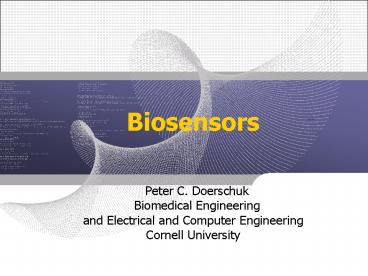Biosensors - PowerPoint PPT Presentation
1 / 15
Title:
Biosensors
Description:
... by sandwich immunoassay for detection by a fluorescence microtiter plate reader and microscopy ... liposomes in a sandwich hybridization assay for Dengue ... – PowerPoint PPT presentation
Number of Views:723
Avg rating:3.0/5.0
Title: Biosensors
1
Biosensors
Peter C. Doerschuk Biomedical Engineering
and Electrical and Computer Engineering Cornell
University
2
- Extensive activity spread throughout Engineering
and Science. - Organization
- Within departments, e.g., BME, ECE, CBE, BEE,
AEP. - Within centers, especially the Nanobiotechnology
Center (NBTC), a National Science Foundation,
Science and Technology Center.
- Goals
- Biosensor devices (really biointerface devices
since both sensing and actuating are of
interest). - Inference and control algorithms for use with
such devices. - Basic science to clinical medicine.
3
- Examples
- Professor Harold Craighead, Applied and
Engineering Physics,Nanobiotechnology Center
(NBTC) (http//www.nbtc.cornell.edu/) - Professor Antje Baeumner, Biological
Environmental Engineering, Bioanalytical
Microsystems Biosensors Lab - (http//hive.bee.cornell.edu/bmb_lab/index.html)
- devices for the detection of hazardous biological
and chemical substances in the environment, in
food, and in medical diagnostics. - Professor Peter Doerschuk, Biomedical
Engineering and Electrical and Computer
Engineering mathematical and statistical models,
signal and image processing, high performance
computing sketch work on an implanted biosensor
for ethanol.
research in biomolecular devices analysis,
cellular microdynamics, cell-surface
interactions, and nanoscale cell biology
4
Bioanalytical Microsystems Biosensors Laboratory
- Department of Biological Environmental
Engineering - 145 Riley-Robb Hall
- Cornell University, Ithaca, NY
- Antje J. Baeumner (PI)/Katie A. Edwards
5
Advantages of Liposomes
- Liposomes can serve as a substitute for
fluorophore, colloidal gold, or enzymatic signal
enhancement - Interior cavity can encapsulate many hydrophilic
signaling molecules - 105-106 dye molecules
- Hydrophobic molecules can be bi-layer
incorporated - Lipid bilayers can be conjugated to
biorecognition elements - Functional groups available for post-formation
conjugation - Direct incorporation
- Facile control over analytical aspects
- Liposome size, degree of conjugation,
concentration of encapsulants - Long-term stability
- Instantaneous signal amplification
6
Comparison to other detection methods
Sandwich immunoassay for cholera toxin, subunit B
using fluorescein, HRP, or dye-encapsulating
liposome labeled antibody. Results are plotted
in terms of signal to noise.
LOD (bkgd3stdev) Maximum SN at maximum
Fluorescein-labeled antibody 13.3 ng/mL 500 ng/mL 3.35
HRP-labeled antibody 2.05 ng/mL 50 ng/mL 1.95
Antibody-tagged liposomes 0.45 ng/mL 500 ng/mL 14.95
7
Recent Work
- Development of rapid lateral flow assays for
- CD4 cells from human blood
- Cryptosporidium parvum
- Pathogenic bacteria (i.e.-Bacillus anthracis,
Escherichia coli) - Dengue virus (serotype specific)
- Herbicides (Alachlor, imazethapyr)
- Development of microtiter plate assays for cell
culture supernatants - Cholera toxin
- Insulin
- Visualization and quantification of cholera toxin
binding to epithelial cells - Encapsulation of DNA oligonucleotides for
detection of - protective antigen from B. anthracis allowed
for multi-analyte - analysis proof of principle
8
Assay Overview
- Biorecognition elements can be conjugated to
liposomal bilayer - Antibodies
- Streptavidin or Protein A/G, Enzymes, Other
Proteins - Small-molecule analytes
- Fluorophores
- Hydrophilic molecules can be encapsulated within
interior cavity - Enzymes
- Fluorophores
- Electrochemical markers
- Oligonucleotides
- Assay types
- Sandwich immunoassays
- Sandwich hybridizations
- Competitive assays
- Assay formats
- Lateral-flow assays
- Microfluidic devices
- Sequential-injection analysis
- Microtiter plates
9
Cholera toxin detection
- Methods to detect on-cell binding of Cholera
toxin and its production in culture supernatants
were developed - Used to visualize and quantify the binding of CT
to Caco-2 epithelial cells co-cultured with V.
cholerae - Detected by sandwich immunoassay for detection by
a fluorescence microtiter plate reader and
microscopy
Sandwich immunoassay using GM1-tagged liposomes.
Limit of detection (bkgd3xStDev) 0.34 ng/mL,
Assay range 1-500 ng/mL, CV 3.7, Assay time
3.5 hours
Caco-2 epithelial cells grown in microtiter
plates and incubated with cholera toxin (CT)
standards or V. cholerae. GM1 tagged fluorophore
labeled liposomes were used to visualize bound CT.
Analytical Biochemistry, vol. 368 (1), p. 39 48
(2007)
10
mRNA detection
- mRNA extracted from culture and amplified using
NASBA - Sandwich-hybridization of amplified RNA target
between reporter probe-tagged liposomes and
immobilized capture probes - Synthetic DNA analogue used for development work
- Assay proven successful for the detection of mRNA
from E. coli, B. anthracis, Dengue virus and C.
parvum
- DNA-tagged liposomes in a sandwich hybridization
assay for B. anthracis atxA mRNA. Limit of
detection (bkgd3xStDev) 0.11 nM, Assay range
0.5-50 nM, CV 4.4, Assay time 1.75 hours
Analytical Bioanalytical Chemistry, vol. 386 (6),
p. 1613 1623 (2006)
11
Dengue virus detection
- Sandwich hybridization detection of amplified
mRNA using LFA with capture probes immobilized in
different zones - Allows for distinction between 4 serotypes
- Sensitivity 10 pfu/mL
Serotype 1 Serotype 2 Serotype 3 Serotype
4 Negative control
DNA-tagged liposomes in a sandwich hybridization
assay for Dengue virus mRNA. Serotype-specific
capture probes were immobilized in spatially
different zones
Analytical Bioanalytical Chemistry, vol. 380 (1),
p. 46 53 (2004)
12
Lab information
- Antje J. Baeumner (PI)/Katie A. Edwards
- 3 Post-doctoral associates
- 3 Ph.D. students
- 1 Research support Specialist
- 4 Undergraduate students
- Present technical capabilities
- Dynamic light scattering
- Sequential injection analyses
- Microfluidic device development
- Lateral flow assay development
- Microtiter plate assay development
- Nucleic Acid Based Sequence Amplification
(NASBA), PCR - Liposome preparation
- Blood handling
13
Ethanol Biosensor Models and Signal Processing
Jae-Joon Han, Martin Plawecki, Peter Doerschuk,
and Sean OConnor
14
(No Transcript)
15
(No Transcript)































